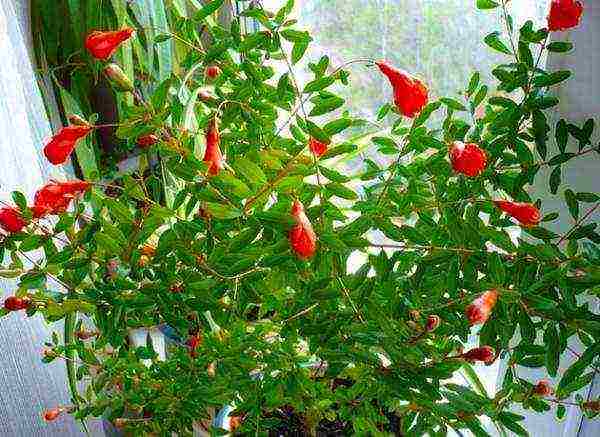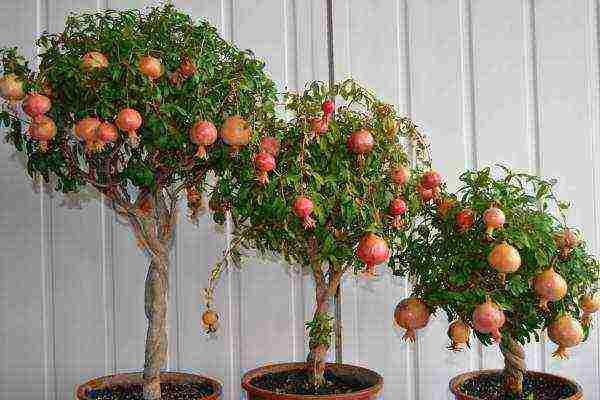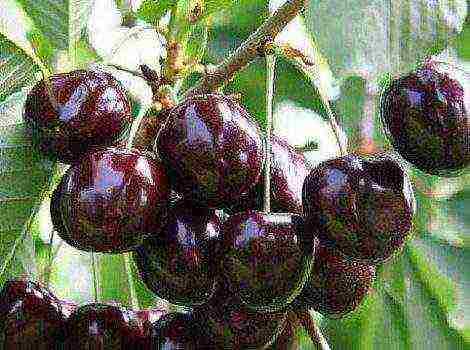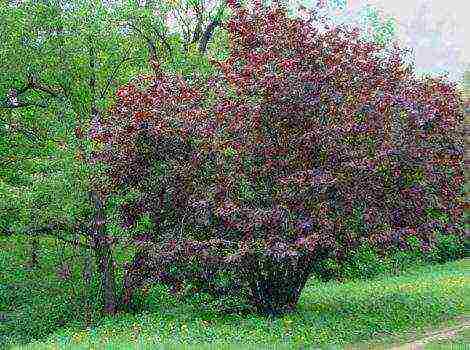Content
Proper care of indoor pomegranate at home
In nature, pomegranate grows as a tree or shrub.... The culture got its name from the Latin word "pomegranate", which means fine-grained.
The fruits of such a plant are quite large in size, painted in a rich red or burgundy color. Pomegranate pulp is made up of many small grains.
In nature, pomegranate grows on mountain slopes or in rocky terrain., which explains the plant's unpretentiousness to the climate and soil composition.
Also such a tree perfectly adapts to the microclimate.
Description of the dwarf pomegranate
Dwarf pomegranate growth directly depends on the variety, the average is 1 meter. Pomegranate flowers deserve special attention.
On one tree, 2 types of flowers are formed at once:
- some flowers have both a pistil and stamens, ovaries are formed on them, and later fruits appear, their shape resembles water lilies;
- another species looks like bells, but the flowers are sexless and only have a decorative function.
The flowers are painted in a bright, red hue and reach a diameter of 3 centimeters.
Scientists call the pomegranate fruit "pomegranate", they reach 18 centimeters in diameter. The skin of such fruits is very dense, its color varies from light pink to dark red.

One fruit can contain up to 1200 grains, which are covered with a juicy, fleshy shell. The taste of the pulp is sweet and sour, very juicy and refreshing; such fruits are often used to make juice.
At home, dwarf pomegranate is grown as an indoor flower, and the appearance of fruits is a pleasant addition.
Is it possible to grow an ornamental plant at home?
It is quite possible to grow a pomegranate at home., among all fruit trees that are grown at home, pomegranate is the most unpretentious.
It is very simple to care for such a plant and you can get juicy fruits without any special efforts.
Indoor conditions grow miniature pomegranates "Nana"... They begin to bloom after they reach a height of 40 centimeters, while bearing up to 10 edible fruits, which differ from garden trees only in size (5-6 centimeters in diameter).
Usually, the following varieties of pomegranate are grown at home:
- Alba captivity - This variety does not bear fruit and is grown for large and beautiful flowers. They are distinguished by a terry structure and cream color, and can reach a diameter of up to 6 centimeters. The leaves of this variety are sinewy, dense, oval, slightly elongated, have a rich green color. The peculiarity of the variety is that it grows very quickly, but if desired, this process can be stopped by planting the plant in a small container.
- Carthage and Baby - the most common indoor varieties, trees grow up to 50 centimeters in height, although there are specimens with a growth equal to 1 meter. A large number of flowers are observed on these plants, and fruits appear starting from the 2nd year of life.
Even though several dozen flowers can bloom at one time, on average, 3-4 ovaries are formed.

Rules for planting a pomegranate tree
To grow a dwarf pomegranate you can use seeds purchased at the store... The best time to plant seeds is the beginning of April.
Drainage is poured onto the bottom of the box or container, then clean river sand, into which pomegranate seeds are deepened by 5 milliliters. Then the soil is moistened and covered with film or glass, this is necessary to achieve the greenhouse effect.
After the first shoots appear, you need to wait another 2 weeks, because pomegranate shoots appear gradually.
As soon as 5-6 healthy leaves appear on the seedlings, it can be transplanted into separate pots, on the bottom of which drainage is poured and a soil mixture is prepared from:
- 2 parts citrus soil;
- 1 part sand;
- 1 part vermicompost.

After the tree is in the pot, it is necessary water abundantly to aid early rooting.
After about a month, the first buds will appear on the cuttings, after which they can be transplanted into separate pots. Rooting will take place much faster if the cutting is placed in a growth stimulator for 6 hours before planting.
This method is less risky., because under such conditions all the varietal qualities of the mother tree are preserved.
Caring for a house tree
In order for the pomegranate to develop well and please with its appearance, it must provide the necessary conditions.
| Period | Care rules |
| In spring and summer | The tree needs as much sunlight as possible, and if the weather is warm outside, many housewives recommend taking the plant out into the fresh air, for such purposes a regular balcony or loggia is perfect. Also during this period, watering the pomegranate should be regular and abundant, in no case should the soil be allowed to dry out. During flowering and fruiting 1 time in 10-14 days the tree is fed with complex mineral fertilizers. Most often, Etisso fertilizer is used for pomegranates; it is sold in two types, both for flowering and for green plants. It is worth remembering that during fruiting, pomegranates are watered especially carefully, the soil must be moist, and an excess of moisture can cause the fruit to crack. In addition to watering, pomegranates are sprayed with warm water once every two weeks. |
| In autumn and winter | With the onset of autumn, the tree can throw off its foliage and go into a dormant phase. in order to create conditions close to natural for the tree, reduce the amount of introduced moisture for about 2-3 months and move the pot to a cool place. To prepare the plant for winter, it is watered with mullein infusion prepared from 100 grams of manure and 1 liter of water. |
After the end of the resting phase, around the middle of February, it is necessary gradually increase the amount of watering and move the plant back to sunlight.
Another point of care will be shaping pruning.... Dwarf pomegranate responds well to such a procedure and can be given almost any shape, the choice of which depends only on personal preference.
Such dates were not chosen by chance, so as not to damage the tree, work is carried out while it is at rest, and there is no active sap flow.
In addition to all procedures, until the age of 5, pomegranates are transplanted annually, gradually increasing the size of the pot from 100 to 500 milliliters, while it is advisable to choose a narrow container shape.
Instead of replanting adult plants, the topsoil is replaced.
How to grow indoor pomegranate:
Diseases and pests
Indoor pomegranate, like any other plant susceptible to the appearance of various diseases and pests, from which you need to get rid of as soon as possible.
Most often, the following ailments are found on such a plant:
| Disease | Description | Ways to fight |
| Powdery mildew | A whitish bloom forms on the leaves of the affected plant, on which dark brown balls are located. Powdery mildew is caused by harmful fungi. Usually, the disease appears due to poor ventilation, temperature changes or humidity levels in the room. Infection from other plants by airborne droplets is also possible. | In the initial stages, a solution made from 5 grams of soda ash and 1 liter of water helps, you can also add 5-10 grams of soap. If the powdery mildew is sufficiently neglected, then it will be necessary to carry out treatment with chemical preparations, for example, scor, topaz or hom. |
| Branch cancer | The bark on the branches is cracking and spongy swellings can be seen at the edges of the chips. The cause of such a disease can be mechanical damage or frostbite. | It is very difficult to get rid of this disease, the only way out is to cut off the damaged branches with a sharp garden knife, treat the wound with a disinfectant and apply a thin layer of garden varnish. |
| Spots on the leaves | Spots appear on the leaves, the color of which ranges from yellow to brown. Such damage indicates excessive soil moisture. | The plant must be transplanted into new soil, if decay has spread to the roots, then the affected parts are removed, and the cut is treated with crushed coal. |
| Whitefly and aphids | Pests feed on the foliage of the tree, which in turn significantly weakens it. | If there are few insects, then they can be removed manually. Adult butterflies are cleaned with an ordinary vacuum cleaner, and you can get rid of larvae and aphids by treating the leaves with a solution of laundry soap. You can also use special drugs. fitoverm, spark, karbofos, etc. Protect the soil with plastic wrap before each treatment. |
The pomegranate tree is considered one of the most unusual ornamental plants., but at the same time caring for him is quite simple.
In addition to the expected fruits, it has an excellent appearance and aroma.


